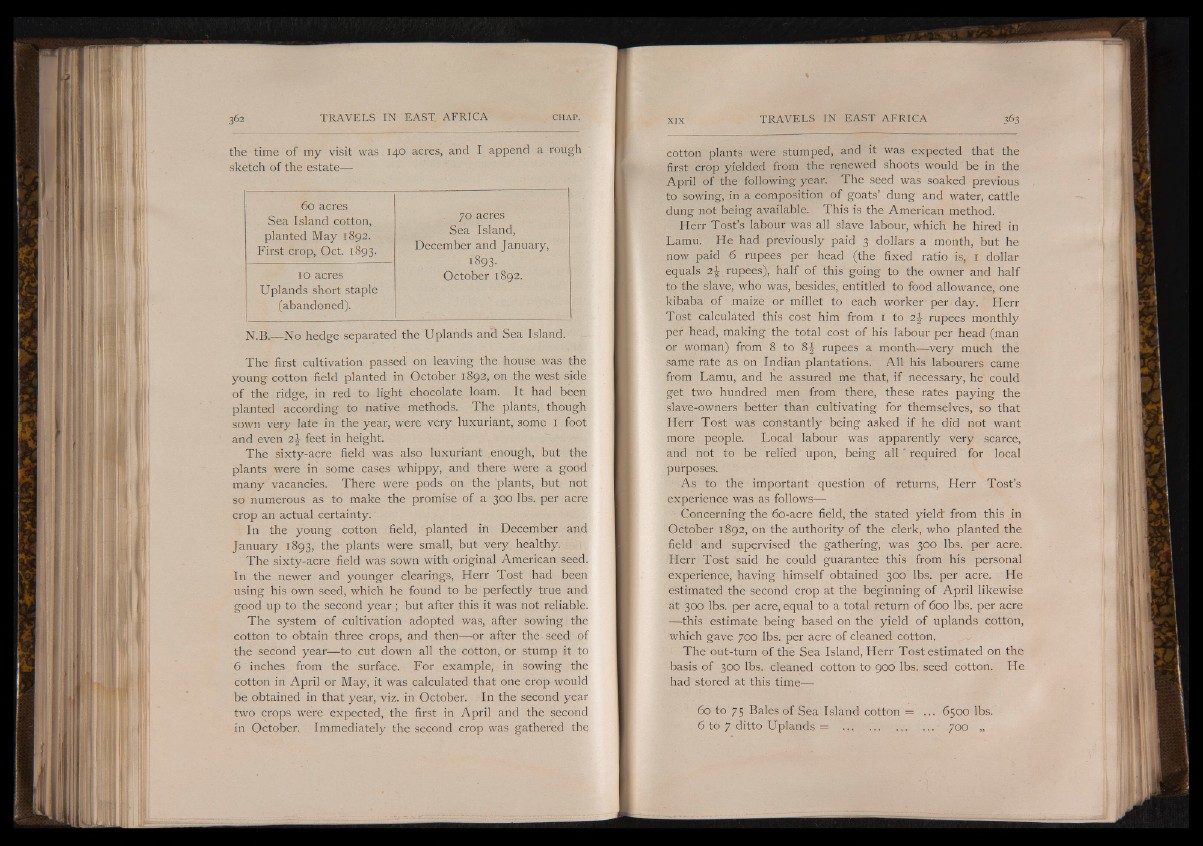
the time of my visit was 140 acres, and I append a rough
sketch of the estate—
60 acres
Sea Island cotton, 70 acres
planted May 1892.
First crop, Oct. 1893.
Sea Island,
December and January,
1893.
1a acres October 1892.
Uplands short staple
(abandoned).
N.B.— No hedge separated the Uplands an’d Sea Island.
The first cultivation passed on leaving the house was the
young cotton field planted in October 1892, on the west side
of the ridge, in red to light chocolate loam. It had been
planted according to native methods. The plants, though
sown very late in the year, were very luxuriant, some 1 foot
and even 2\ feet in height.
The sixty-acre field was also luxuriant enough, but the
plants were in some cases whippy, and there were a good
many vacancies. There were pods on the plants, but not
so numerous as to make the promise of a 300 lbs. per acre
crop an actual certainty.
In the young cotton field, planted in December and
January 1893, the plants were small, but very healthy.
The sixty-acre field was sown with original American seed.
In the newer and younger clearings, Herr Tost had been
using his own seed, which he found to be perfectly true and
good up to the second year ; but after this it was not reliable.
The system of cultivation adopted was, after sowing the
cotton to obtain three crops, and then— or after the seed of
the second year— to cut down all the cotton, or stump it to
6 inches from the surface. For example, in sowing the
cotton in April or May, it was calculated that one crop would
be obtained in that year, viz. in October. In the second year
two crops were expected, the first in April and thè second
in October, Immediately the second crop was gathered the
cotton plants were stumped, and it was expected that the
first crop yielded from the renewed shoots would be in the
April of the following year. The seed was soaked previous
to sowing, in a composition of goats’ dung and water, cattle
dung not being available. This is the American method.
Herr Tost’s labour was all slave labour, which he hired in
Lamu. He had previously paid 3 dollars a month, but he
now paid 6 rupees per head (the fixed ratio is, 1 dollar
equals 2\ rupees), half of this going to the owner and half
to the slave, who was, besides, entitled to food allowance, one
kibaba of maize or millet to each worker per day. Herr
Tost calculated this cost him from 1 to 2-| rupees monthly
per head, making the total cost of his labour per head (man
or woman) from 8 to 8£ rupees a month— very much the
same rate as on Indian plantations. All his labourers came
from Lamu, and he assured me that, if necessary, he could
get two hundred men from there, these rates paying the
slave-owners better than cultivating for themselves, so that
Herr Tost was constantly being asked if he did not want
more people. Local labour was apparently very scarce,
and not to be relied upon, being a l l ' required for local
purposes.
As to the important question of returns, Herr Tost’s
experience was as follows—
Concerning the 60-acre field, the stated yieldr from this in
October 1892, on the authority of the clerk, who planted the
field and supervised the gathering, was 300 lbs. per acre.
Herr Tost said he could guarantee this from his personal
experience, having himself obtained 300 lbs. per acre. He
estimated the second crop at the beginning of April likewise
at 300 lbs. per acre, equal to a total return of 600 lbs. per acre
— this estimate being based on the yield of uplands cotton,
which gave 700 lbs. per acre of cleaned cotton.
The out-turn of the Sea Island, Herr Tost estimated on the
basis of 300 lbs. cleaned cotton to 900 lbs. seed cotton. He
had stored at this time—
60 to 75 Bales of Sea Island cotton = ... 6500 lbs.
6 to 7 ditto Uplands = .., ,,, 700 „